Master of Mental Health Nursing: Youth Suicide in Australia Report
VerifiedAdded on 2023/06/05
|12
|4177
|213
Report
AI Summary
This report delves into the critical issue of youth suicide, examining its global and national significance, with a specific focus on Australia. It begins by providing an overview of the problem, highlighting its impact on young people aged 15-24 and the contributing factors, including self-poisoning, firearms, and hanging, and the role of mental disorders. The report then discusses developed initiatives, such as the adaptation of the LIFE model and the YAM program, and analyzes their strengths and weaknesses. Key learnings from implementation are explored, emphasizing the importance of universal, selective, and indicated prevention models, as well as the need for coordinated and integrated interventions. The report offers recommendations to enhance the effectiveness of initiatives in Australia, including the recognition of stress and mental trauma, the use of technology for monitoring, and the involvement of educators. Finally, the report provides evidence-based discussions, reflecting on international aspects and suggesting future policy directions to address the complex issue of youth suicide.
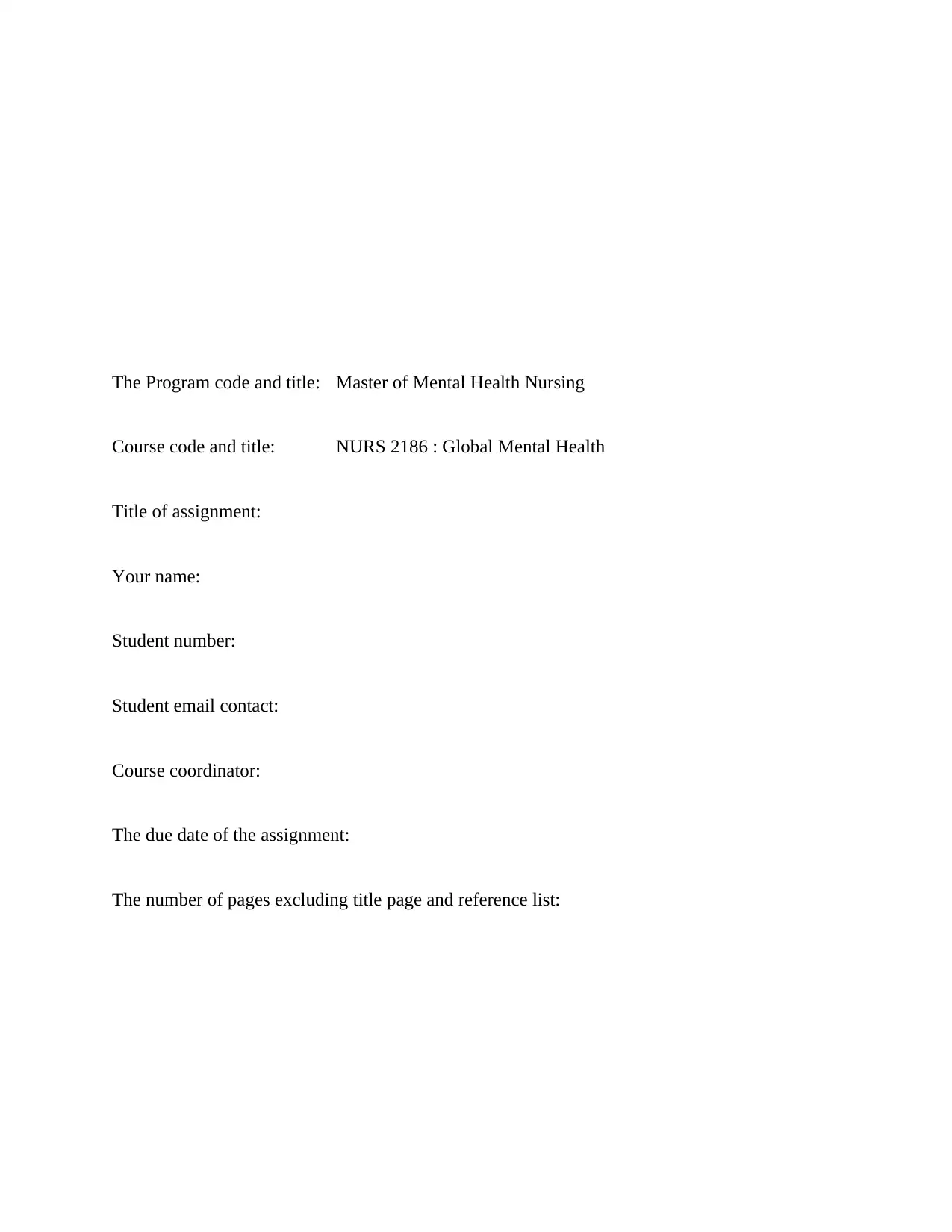
The Program code and title: Master of Mental Health Nursing
Course code and title: NURS 2186 : Global Mental Health
Title of assignment:
Your name:
Student number:
Student email contact:
Course coordinator:
The due date of the assignment:
The number of pages excluding title page and reference list:
Course code and title: NURS 2186 : Global Mental Health
Title of assignment:
Your name:
Student number:
Student email contact:
Course coordinator:
The due date of the assignment:
The number of pages excluding title page and reference list:
Paraphrase This Document
Need a fresh take? Get an instant paraphrase of this document with our AI Paraphraser
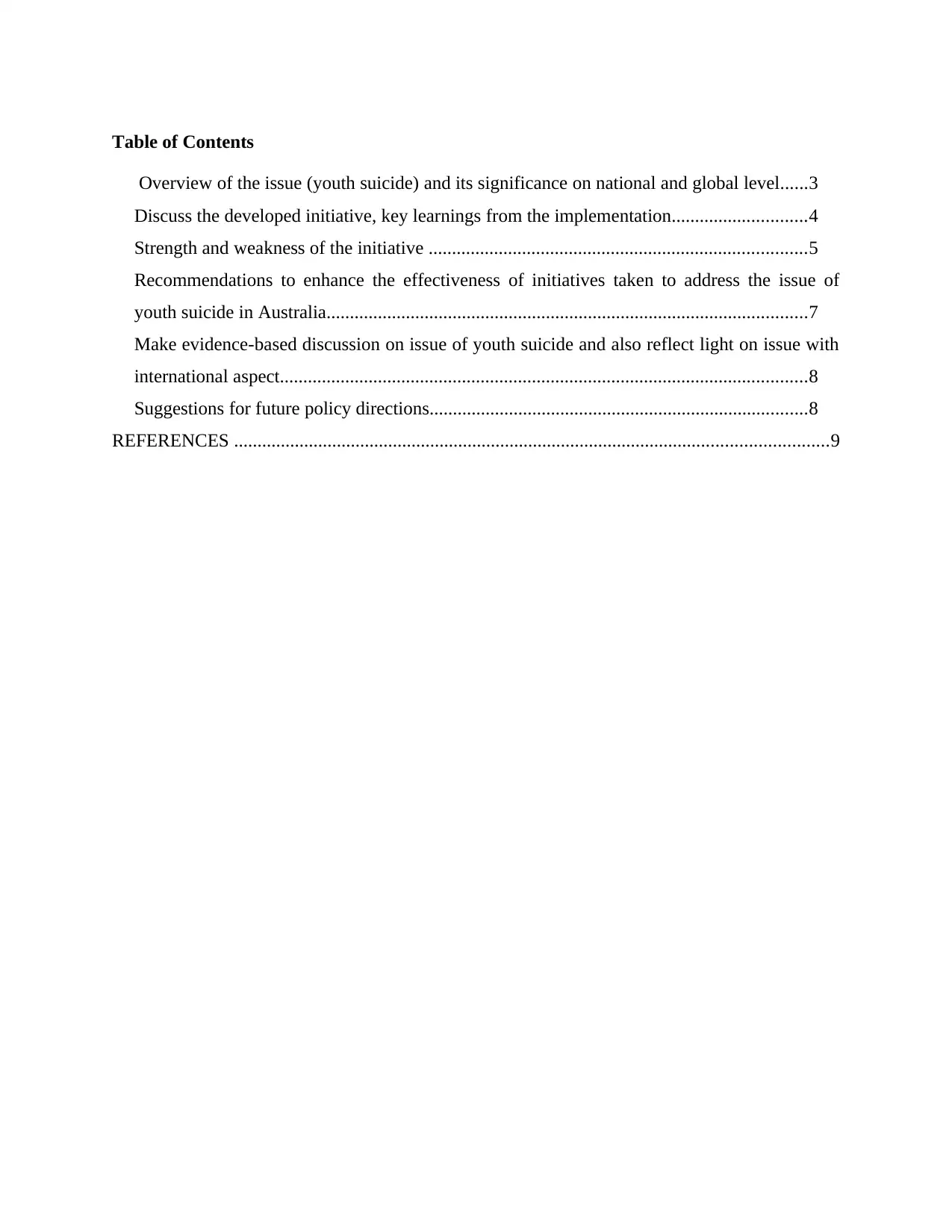
Table of Contents
Overview of the issue (youth suicide) and its significance on national and global level......3
Discuss the developed initiative, key learnings from the implementation.............................4
Strength and weakness of the initiative .................................................................................5
Recommendations to enhance the effectiveness of initiatives taken to address the issue of
youth suicide in Australia.......................................................................................................7
Make evidence-based discussion on issue of youth suicide and also reflect light on issue with
international aspect.................................................................................................................8
Suggestions for future policy directions.................................................................................8
REFERENCES ...............................................................................................................................9
Overview of the issue (youth suicide) and its significance on national and global level......3
Discuss the developed initiative, key learnings from the implementation.............................4
Strength and weakness of the initiative .................................................................................5
Recommendations to enhance the effectiveness of initiatives taken to address the issue of
youth suicide in Australia.......................................................................................................7
Make evidence-based discussion on issue of youth suicide and also reflect light on issue with
international aspect.................................................................................................................8
Suggestions for future policy directions.................................................................................8
REFERENCES ...............................................................................................................................9
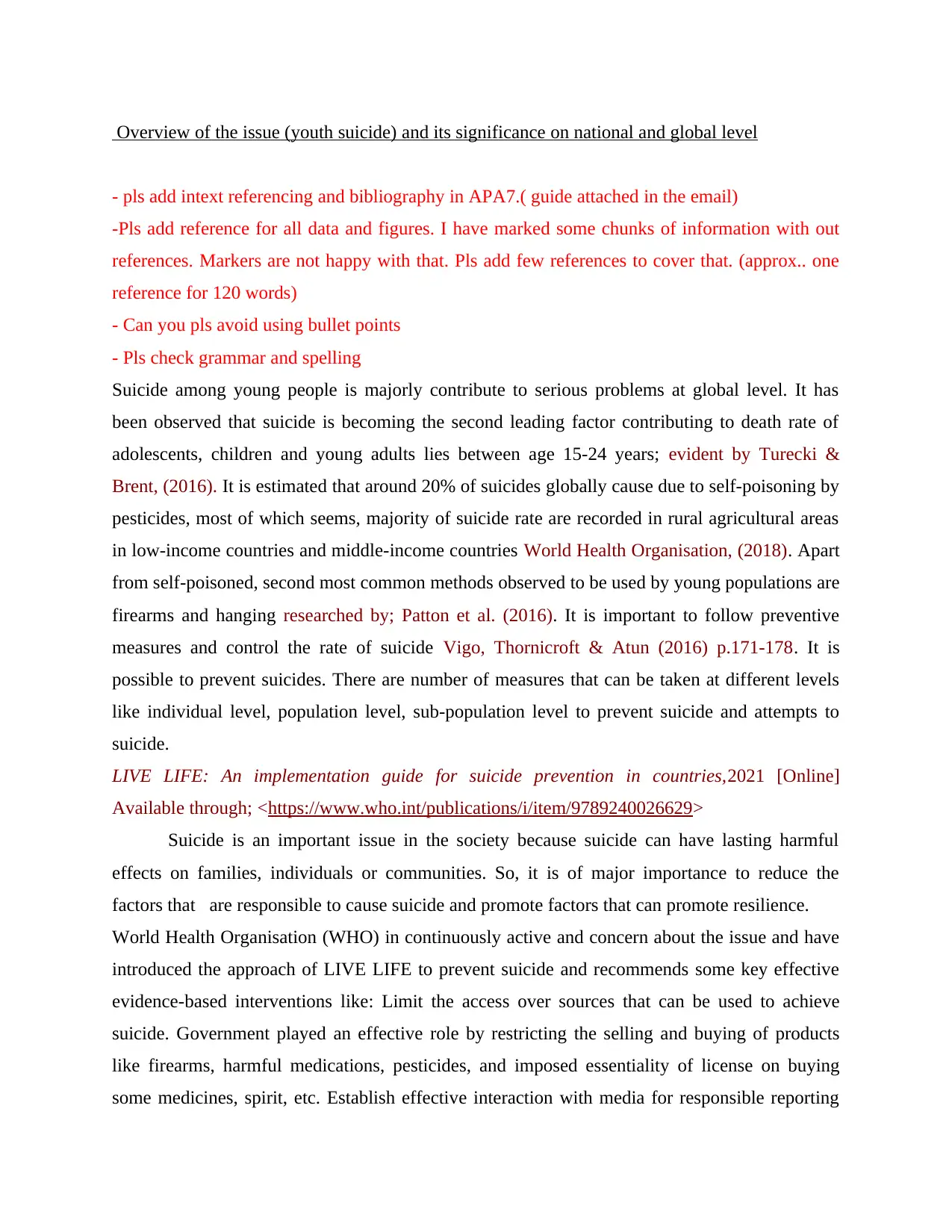
Overview of the issue (youth suicide) and its significance on national and global level
- pls add intext referencing and bibliography in APA7.( guide attached in the email)
-Pls add reference for all data and figures. I have marked some chunks of information with out
references. Markers are not happy with that. Pls add few references to cover that. (approx.. one
reference for 120 words)
- Can you pls avoid using bullet points
- Pls check grammar and spelling
Suicide among young people is majorly contribute to serious problems at global level. It has
been observed that suicide is becoming the second leading factor contributing to death rate of
adolescents, children and young adults lies between age 15-24 years; evident by Turecki &
Brent, (2016). It is estimated that around 20% of suicides globally cause due to self-poisoning by
pesticides, most of which seems, majority of suicide rate are recorded in rural agricultural areas
in low-income countries and middle-income countries World Health Organisation, (2018). Apart
from self-poisoned, second most common methods observed to be used by young populations are
firearms and hanging researched by; Patton et al. (2016). It is important to follow preventive
measures and control the rate of suicide Vigo, Thornicroft & Atun (2016) p.171-178. It is
possible to prevent suicides. There are number of measures that can be taken at different levels
like individual level, population level, sub-population level to prevent suicide and attempts to
suicide.
LIVE LIFE: An implementation guide for suicide prevention in countries,2021 [Online]
Available through; <https://www.who.int/publications/i/item/9789240026629>
Suicide is an important issue in the society because suicide can have lasting harmful
effects on families, individuals or communities. So, it is of major importance to reduce the
factors that are responsible to cause suicide and promote factors that can promote resilience.
World Health Organisation (WHO) in continuously active and concern about the issue and have
introduced the approach of LIVE LIFE to prevent suicide and recommends some key effective
evidence-based interventions like: Limit the access over sources that can be used to achieve
suicide. Government played an effective role by restricting the selling and buying of products
like firearms, harmful medications, pesticides, and imposed essentiality of license on buying
some medicines, spirit, etc. Establish effective interaction with media for responsible reporting
- pls add intext referencing and bibliography in APA7.( guide attached in the email)
-Pls add reference for all data and figures. I have marked some chunks of information with out
references. Markers are not happy with that. Pls add few references to cover that. (approx.. one
reference for 120 words)
- Can you pls avoid using bullet points
- Pls check grammar and spelling
Suicide among young people is majorly contribute to serious problems at global level. It has
been observed that suicide is becoming the second leading factor contributing to death rate of
adolescents, children and young adults lies between age 15-24 years; evident by Turecki &
Brent, (2016). It is estimated that around 20% of suicides globally cause due to self-poisoning by
pesticides, most of which seems, majority of suicide rate are recorded in rural agricultural areas
in low-income countries and middle-income countries World Health Organisation, (2018). Apart
from self-poisoned, second most common methods observed to be used by young populations are
firearms and hanging researched by; Patton et al. (2016). It is important to follow preventive
measures and control the rate of suicide Vigo, Thornicroft & Atun (2016) p.171-178. It is
possible to prevent suicides. There are number of measures that can be taken at different levels
like individual level, population level, sub-population level to prevent suicide and attempts to
suicide.
LIVE LIFE: An implementation guide for suicide prevention in countries,2021 [Online]
Available through; <https://www.who.int/publications/i/item/9789240026629>
Suicide is an important issue in the society because suicide can have lasting harmful
effects on families, individuals or communities. So, it is of major importance to reduce the
factors that are responsible to cause suicide and promote factors that can promote resilience.
World Health Organisation (WHO) in continuously active and concern about the issue and have
introduced the approach of LIVE LIFE to prevent suicide and recommends some key effective
evidence-based interventions like: Limit the access over sources that can be used to achieve
suicide. Government played an effective role by restricting the selling and buying of products
like firearms, harmful medications, pesticides, and imposed essentiality of license on buying
some medicines, spirit, etc. Establish effective interaction with media for responsible reporting
⊘ This is a preview!⊘
Do you want full access?
Subscribe today to unlock all pages.

Trusted by 1+ million students worldwide
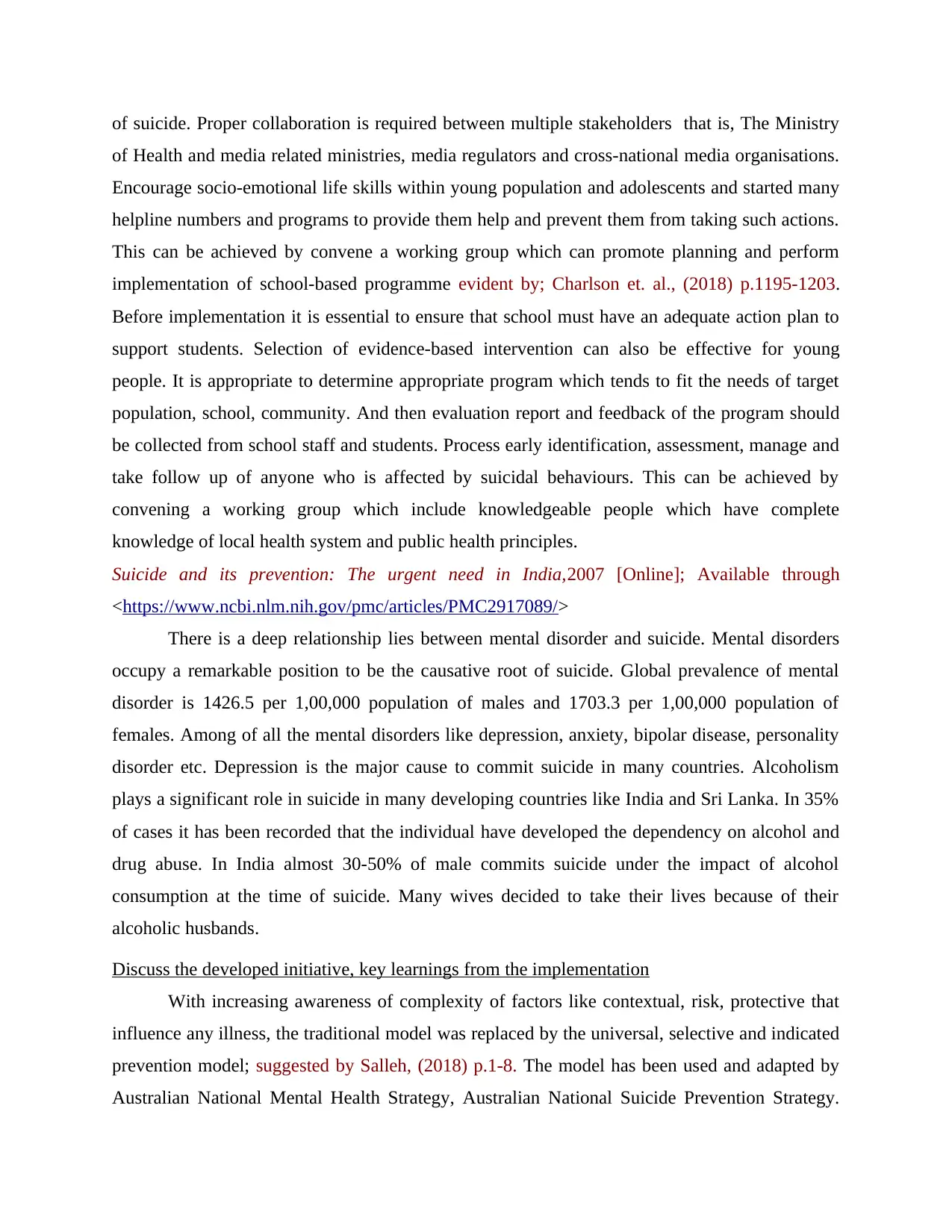
of suicide. Proper collaboration is required between multiple stakeholders that is, The Ministry
of Health and media related ministries, media regulators and cross-national media organisations.
Encourage socio-emotional life skills within young population and adolescents and started many
helpline numbers and programs to provide them help and prevent them from taking such actions.
This can be achieved by convene a working group which can promote planning and perform
implementation of school-based programme evident by; Charlson et. al., (2018) p.1195-1203.
Before implementation it is essential to ensure that school must have an adequate action plan to
support students. Selection of evidence-based intervention can also be effective for young
people. It is appropriate to determine appropriate program which tends to fit the needs of target
population, school, community. And then evaluation report and feedback of the program should
be collected from school staff and students. Process early identification, assessment, manage and
take follow up of anyone who is affected by suicidal behaviours. This can be achieved by
convening a working group which include knowledgeable people which have complete
knowledge of local health system and public health principles.
Suicide and its prevention: The urgent need in India,2007 [Online]; Available through
<https://www.ncbi.nlm.nih.gov/pmc/articles/PMC2917089/>
There is a deep relationship lies between mental disorder and suicide. Mental disorders
occupy a remarkable position to be the causative root of suicide. Global prevalence of mental
disorder is 1426.5 per 1,00,000 population of males and 1703.3 per 1,00,000 population of
females. Among of all the mental disorders like depression, anxiety, bipolar disease, personality
disorder etc. Depression is the major cause to commit suicide in many countries. Alcoholism
plays a significant role in suicide in many developing countries like India and Sri Lanka. In 35%
of cases it has been recorded that the individual have developed the dependency on alcohol and
drug abuse. In India almost 30-50% of male commits suicide under the impact of alcohol
consumption at the time of suicide. Many wives decided to take their lives because of their
alcoholic husbands.
Discuss the developed initiative, key learnings from the implementation
With increasing awareness of complexity of factors like contextual, risk, protective that
influence any illness, the traditional model was replaced by the universal, selective and indicated
prevention model; suggested by Salleh, (2018) p.1-8. The model has been used and adapted by
Australian National Mental Health Strategy, Australian National Suicide Prevention Strategy.
of Health and media related ministries, media regulators and cross-national media organisations.
Encourage socio-emotional life skills within young population and adolescents and started many
helpline numbers and programs to provide them help and prevent them from taking such actions.
This can be achieved by convene a working group which can promote planning and perform
implementation of school-based programme evident by; Charlson et. al., (2018) p.1195-1203.
Before implementation it is essential to ensure that school must have an adequate action plan to
support students. Selection of evidence-based intervention can also be effective for young
people. It is appropriate to determine appropriate program which tends to fit the needs of target
population, school, community. And then evaluation report and feedback of the program should
be collected from school staff and students. Process early identification, assessment, manage and
take follow up of anyone who is affected by suicidal behaviours. This can be achieved by
convening a working group which include knowledgeable people which have complete
knowledge of local health system and public health principles.
Suicide and its prevention: The urgent need in India,2007 [Online]; Available through
<https://www.ncbi.nlm.nih.gov/pmc/articles/PMC2917089/>
There is a deep relationship lies between mental disorder and suicide. Mental disorders
occupy a remarkable position to be the causative root of suicide. Global prevalence of mental
disorder is 1426.5 per 1,00,000 population of males and 1703.3 per 1,00,000 population of
females. Among of all the mental disorders like depression, anxiety, bipolar disease, personality
disorder etc. Depression is the major cause to commit suicide in many countries. Alcoholism
plays a significant role in suicide in many developing countries like India and Sri Lanka. In 35%
of cases it has been recorded that the individual have developed the dependency on alcohol and
drug abuse. In India almost 30-50% of male commits suicide under the impact of alcohol
consumption at the time of suicide. Many wives decided to take their lives because of their
alcoholic husbands.
Discuss the developed initiative, key learnings from the implementation
With increasing awareness of complexity of factors like contextual, risk, protective that
influence any illness, the traditional model was replaced by the universal, selective and indicated
prevention model; suggested by Salleh, (2018) p.1-8. The model has been used and adapted by
Australian National Mental Health Strategy, Australian National Suicide Prevention Strategy.
Paraphrase This Document
Need a fresh take? Get an instant paraphrase of this document with our AI Paraphraser
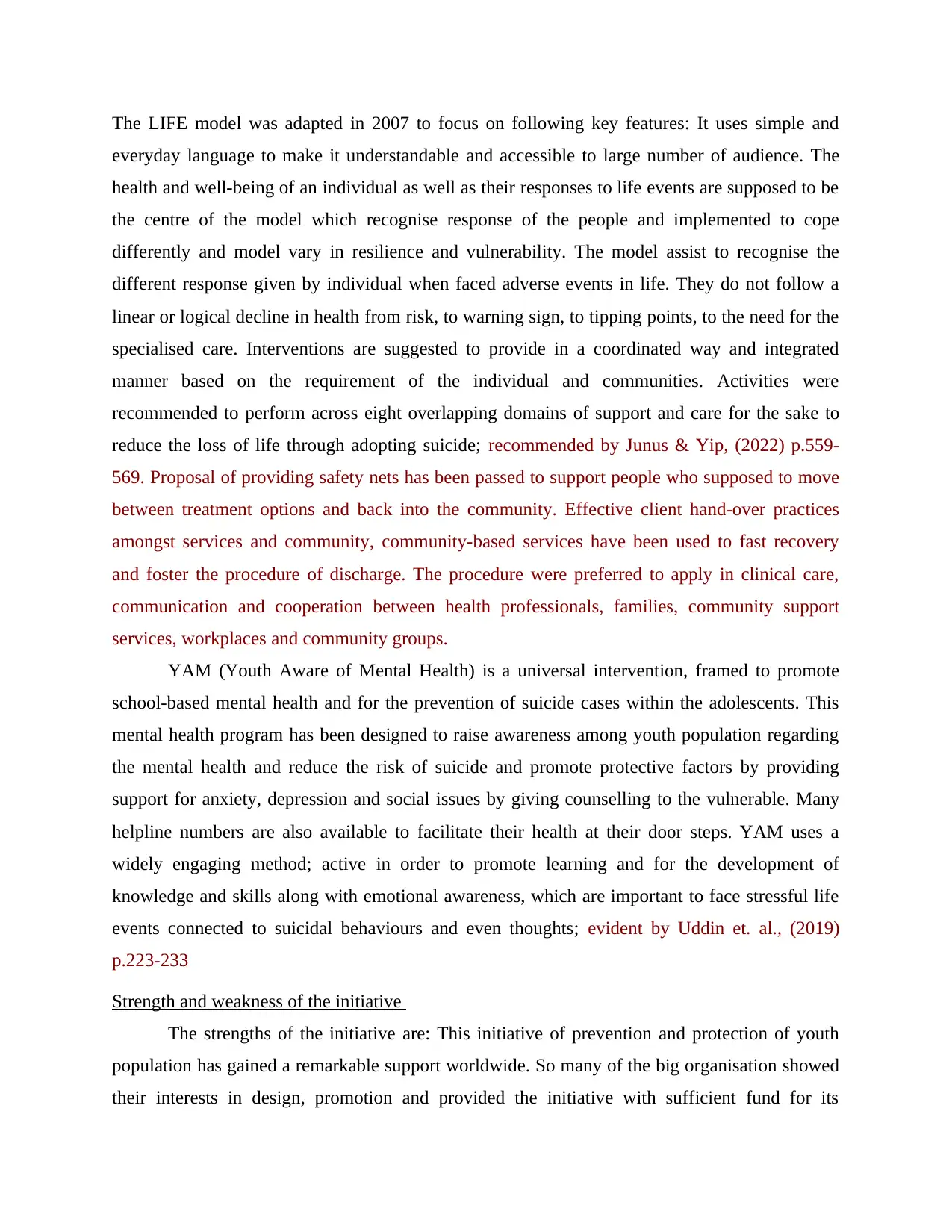
The LIFE model was adapted in 2007 to focus on following key features: It uses simple and
everyday language to make it understandable and accessible to large number of audience. The
health and well-being of an individual as well as their responses to life events are supposed to be
the centre of the model which recognise response of the people and implemented to cope
differently and model vary in resilience and vulnerability. The model assist to recognise the
different response given by individual when faced adverse events in life. They do not follow a
linear or logical decline in health from risk, to warning sign, to tipping points, to the need for the
specialised care. Interventions are suggested to provide in a coordinated way and integrated
manner based on the requirement of the individual and communities. Activities were
recommended to perform across eight overlapping domains of support and care for the sake to
reduce the loss of life through adopting suicide; recommended by Junus & Yip, (2022) p.559-
569. Proposal of providing safety nets has been passed to support people who supposed to move
between treatment options and back into the community. Effective client hand-over practices
amongst services and community, community-based services have been used to fast recovery
and foster the procedure of discharge. The procedure were preferred to apply in clinical care,
communication and cooperation between health professionals, families, community support
services, workplaces and community groups.
YAM (Youth Aware of Mental Health) is a universal intervention, framed to promote
school-based mental health and for the prevention of suicide cases within the adolescents. This
mental health program has been designed to raise awareness among youth population regarding
the mental health and reduce the risk of suicide and promote protective factors by providing
support for anxiety, depression and social issues by giving counselling to the vulnerable. Many
helpline numbers are also available to facilitate their health at their door steps. YAM uses a
widely engaging method; active in order to promote learning and for the development of
knowledge and skills along with emotional awareness, which are important to face stressful life
events connected to suicidal behaviours and even thoughts; evident by Uddin et. al., (2019)
p.223-233
Strength and weakness of the initiative
The strengths of the initiative are: This initiative of prevention and protection of youth
population has gained a remarkable support worldwide. So many of the big organisation showed
their interests in design, promotion and provided the initiative with sufficient fund for its
everyday language to make it understandable and accessible to large number of audience. The
health and well-being of an individual as well as their responses to life events are supposed to be
the centre of the model which recognise response of the people and implemented to cope
differently and model vary in resilience and vulnerability. The model assist to recognise the
different response given by individual when faced adverse events in life. They do not follow a
linear or logical decline in health from risk, to warning sign, to tipping points, to the need for the
specialised care. Interventions are suggested to provide in a coordinated way and integrated
manner based on the requirement of the individual and communities. Activities were
recommended to perform across eight overlapping domains of support and care for the sake to
reduce the loss of life through adopting suicide; recommended by Junus & Yip, (2022) p.559-
569. Proposal of providing safety nets has been passed to support people who supposed to move
between treatment options and back into the community. Effective client hand-over practices
amongst services and community, community-based services have been used to fast recovery
and foster the procedure of discharge. The procedure were preferred to apply in clinical care,
communication and cooperation between health professionals, families, community support
services, workplaces and community groups.
YAM (Youth Aware of Mental Health) is a universal intervention, framed to promote
school-based mental health and for the prevention of suicide cases within the adolescents. This
mental health program has been designed to raise awareness among youth population regarding
the mental health and reduce the risk of suicide and promote protective factors by providing
support for anxiety, depression and social issues by giving counselling to the vulnerable. Many
helpline numbers are also available to facilitate their health at their door steps. YAM uses a
widely engaging method; active in order to promote learning and for the development of
knowledge and skills along with emotional awareness, which are important to face stressful life
events connected to suicidal behaviours and even thoughts; evident by Uddin et. al., (2019)
p.223-233
Strength and weakness of the initiative
The strengths of the initiative are: This initiative of prevention and protection of youth
population has gained a remarkable support worldwide. So many of the big organisation showed
their interests in design, promotion and provided the initiative with sufficient fund for its
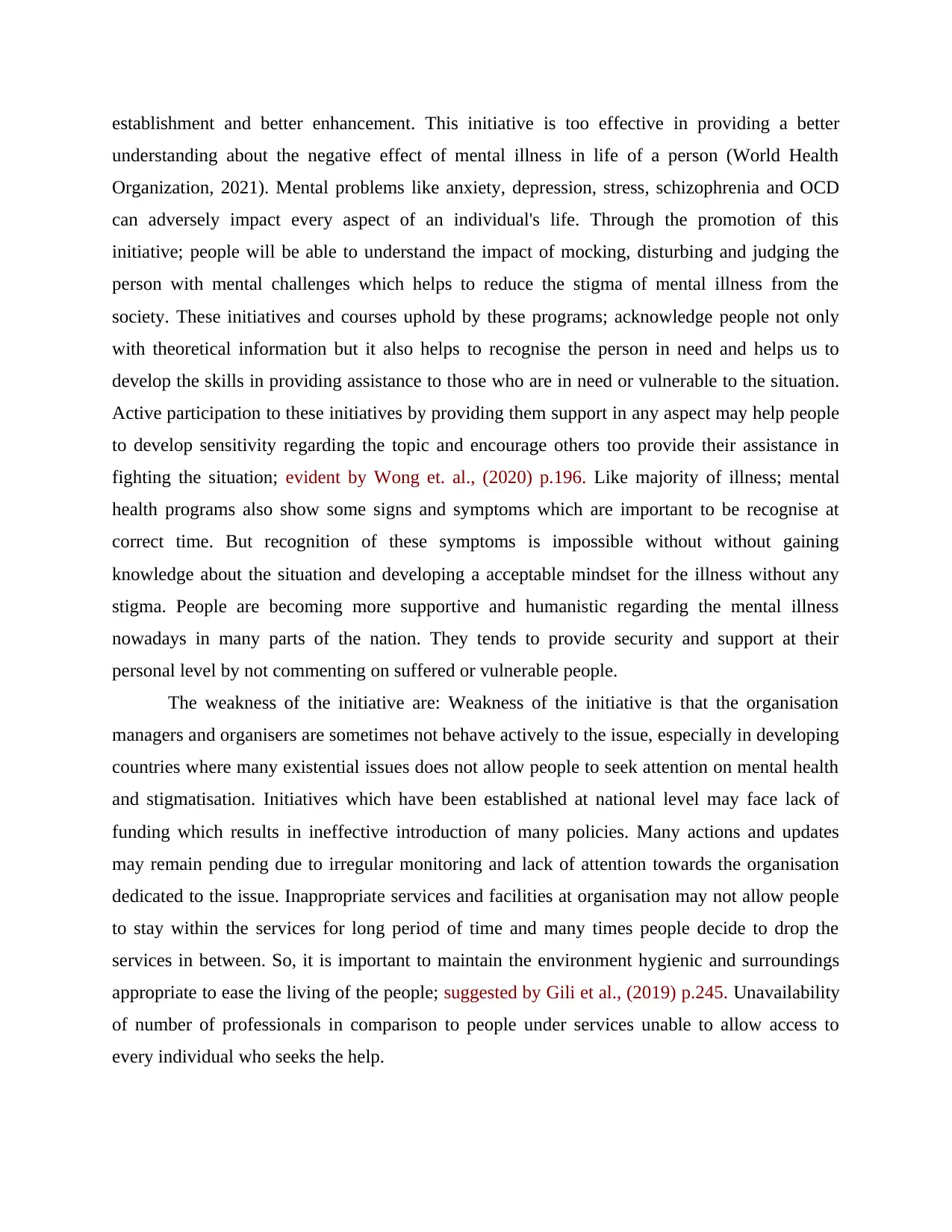
establishment and better enhancement. This initiative is too effective in providing a better
understanding about the negative effect of mental illness in life of a person (World Health
Organization, 2021). Mental problems like anxiety, depression, stress, schizophrenia and OCD
can adversely impact every aspect of an individual's life. Through the promotion of this
initiative; people will be able to understand the impact of mocking, disturbing and judging the
person with mental challenges which helps to reduce the stigma of mental illness from the
society. These initiatives and courses uphold by these programs; acknowledge people not only
with theoretical information but it also helps to recognise the person in need and helps us to
develop the skills in providing assistance to those who are in need or vulnerable to the situation.
Active participation to these initiatives by providing them support in any aspect may help people
to develop sensitivity regarding the topic and encourage others too provide their assistance in
fighting the situation; evident by Wong et. al., (2020) p.196. Like majority of illness; mental
health programs also show some signs and symptoms which are important to be recognise at
correct time. But recognition of these symptoms is impossible without without gaining
knowledge about the situation and developing a acceptable mindset for the illness without any
stigma. People are becoming more supportive and humanistic regarding the mental illness
nowadays in many parts of the nation. They tends to provide security and support at their
personal level by not commenting on suffered or vulnerable people.
The weakness of the initiative are: Weakness of the initiative is that the organisation
managers and organisers are sometimes not behave actively to the issue, especially in developing
countries where many existential issues does not allow people to seek attention on mental health
and stigmatisation. Initiatives which have been established at national level may face lack of
funding which results in ineffective introduction of many policies. Many actions and updates
may remain pending due to irregular monitoring and lack of attention towards the organisation
dedicated to the issue. Inappropriate services and facilities at organisation may not allow people
to stay within the services for long period of time and many times people decide to drop the
services in between. So, it is important to maintain the environment hygienic and surroundings
appropriate to ease the living of the people; suggested by Gili et al., (2019) p.245. Unavailability
of number of professionals in comparison to people under services unable to allow access to
every individual who seeks the help.
understanding about the negative effect of mental illness in life of a person (World Health
Organization, 2021). Mental problems like anxiety, depression, stress, schizophrenia and OCD
can adversely impact every aspect of an individual's life. Through the promotion of this
initiative; people will be able to understand the impact of mocking, disturbing and judging the
person with mental challenges which helps to reduce the stigma of mental illness from the
society. These initiatives and courses uphold by these programs; acknowledge people not only
with theoretical information but it also helps to recognise the person in need and helps us to
develop the skills in providing assistance to those who are in need or vulnerable to the situation.
Active participation to these initiatives by providing them support in any aspect may help people
to develop sensitivity regarding the topic and encourage others too provide their assistance in
fighting the situation; evident by Wong et. al., (2020) p.196. Like majority of illness; mental
health programs also show some signs and symptoms which are important to be recognise at
correct time. But recognition of these symptoms is impossible without without gaining
knowledge about the situation and developing a acceptable mindset for the illness without any
stigma. People are becoming more supportive and humanistic regarding the mental illness
nowadays in many parts of the nation. They tends to provide security and support at their
personal level by not commenting on suffered or vulnerable people.
The weakness of the initiative are: Weakness of the initiative is that the organisation
managers and organisers are sometimes not behave actively to the issue, especially in developing
countries where many existential issues does not allow people to seek attention on mental health
and stigmatisation. Initiatives which have been established at national level may face lack of
funding which results in ineffective introduction of many policies. Many actions and updates
may remain pending due to irregular monitoring and lack of attention towards the organisation
dedicated to the issue. Inappropriate services and facilities at organisation may not allow people
to stay within the services for long period of time and many times people decide to drop the
services in between. So, it is important to maintain the environment hygienic and surroundings
appropriate to ease the living of the people; suggested by Gili et al., (2019) p.245. Unavailability
of number of professionals in comparison to people under services unable to allow access to
every individual who seeks the help.
⊘ This is a preview!⊘
Do you want full access?
Subscribe today to unlock all pages.

Trusted by 1+ million students worldwide
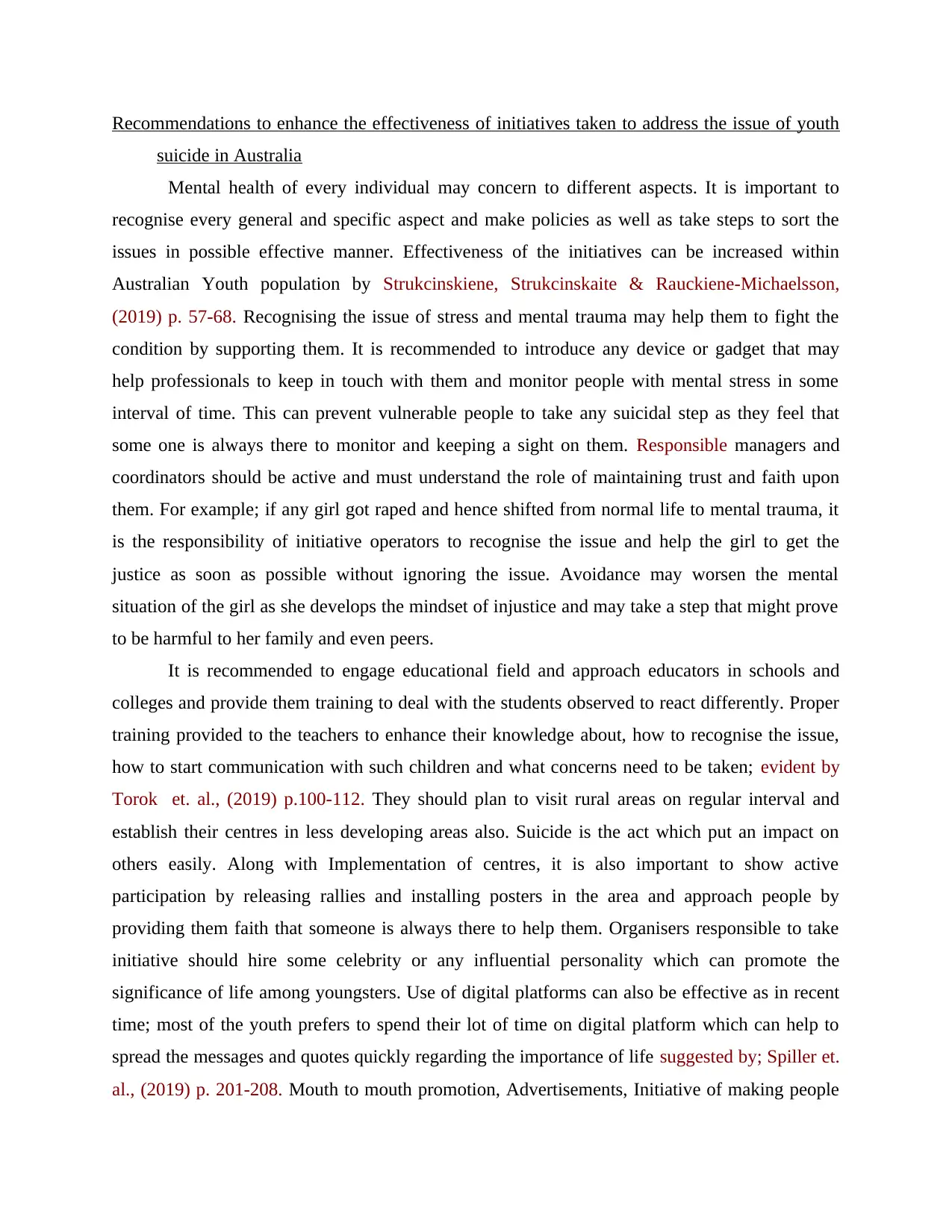
Recommendations to enhance the effectiveness of initiatives taken to address the issue of youth
suicide in Australia
Mental health of every individual may concern to different aspects. It is important to
recognise every general and specific aspect and make policies as well as take steps to sort the
issues in possible effective manner. Effectiveness of the initiatives can be increased within
Australian Youth population by Strukcinskiene, Strukcinskaite & Rauckiene-Michaelsson,
(2019) p. 57-68. Recognising the issue of stress and mental trauma may help them to fight the
condition by supporting them. It is recommended to introduce any device or gadget that may
help professionals to keep in touch with them and monitor people with mental stress in some
interval of time. This can prevent vulnerable people to take any suicidal step as they feel that
some one is always there to monitor and keeping a sight on them. Responsible managers and
coordinators should be active and must understand the role of maintaining trust and faith upon
them. For example; if any girl got raped and hence shifted from normal life to mental trauma, it
is the responsibility of initiative operators to recognise the issue and help the girl to get the
justice as soon as possible without ignoring the issue. Avoidance may worsen the mental
situation of the girl as she develops the mindset of injustice and may take a step that might prove
to be harmful to her family and even peers.
It is recommended to engage educational field and approach educators in schools and
colleges and provide them training to deal with the students observed to react differently. Proper
training provided to the teachers to enhance their knowledge about, how to recognise the issue,
how to start communication with such children and what concerns need to be taken; evident by
Torok et. al., (2019) p.100-112. They should plan to visit rural areas on regular interval and
establish their centres in less developing areas also. Suicide is the act which put an impact on
others easily. Along with Implementation of centres, it is also important to show active
participation by releasing rallies and installing posters in the area and approach people by
providing them faith that someone is always there to help them. Organisers responsible to take
initiative should hire some celebrity or any influential personality which can promote the
significance of life among youngsters. Use of digital platforms can also be effective as in recent
time; most of the youth prefers to spend their lot of time on digital platform which can help to
spread the messages and quotes quickly regarding the importance of life suggested by; Spiller et.
al., (2019) p. 201-208. Mouth to mouth promotion, Advertisements, Initiative of making people
suicide in Australia
Mental health of every individual may concern to different aspects. It is important to
recognise every general and specific aspect and make policies as well as take steps to sort the
issues in possible effective manner. Effectiveness of the initiatives can be increased within
Australian Youth population by Strukcinskiene, Strukcinskaite & Rauckiene-Michaelsson,
(2019) p. 57-68. Recognising the issue of stress and mental trauma may help them to fight the
condition by supporting them. It is recommended to introduce any device or gadget that may
help professionals to keep in touch with them and monitor people with mental stress in some
interval of time. This can prevent vulnerable people to take any suicidal step as they feel that
some one is always there to monitor and keeping a sight on them. Responsible managers and
coordinators should be active and must understand the role of maintaining trust and faith upon
them. For example; if any girl got raped and hence shifted from normal life to mental trauma, it
is the responsibility of initiative operators to recognise the issue and help the girl to get the
justice as soon as possible without ignoring the issue. Avoidance may worsen the mental
situation of the girl as she develops the mindset of injustice and may take a step that might prove
to be harmful to her family and even peers.
It is recommended to engage educational field and approach educators in schools and
colleges and provide them training to deal with the students observed to react differently. Proper
training provided to the teachers to enhance their knowledge about, how to recognise the issue,
how to start communication with such children and what concerns need to be taken; evident by
Torok et. al., (2019) p.100-112. They should plan to visit rural areas on regular interval and
establish their centres in less developing areas also. Suicide is the act which put an impact on
others easily. Along with Implementation of centres, it is also important to show active
participation by releasing rallies and installing posters in the area and approach people by
providing them faith that someone is always there to help them. Organisers responsible to take
initiative should hire some celebrity or any influential personality which can promote the
significance of life among youngsters. Use of digital platforms can also be effective as in recent
time; most of the youth prefers to spend their lot of time on digital platform which can help to
spread the messages and quotes quickly regarding the importance of life suggested by; Spiller et.
al., (2019) p. 201-208. Mouth to mouth promotion, Advertisements, Initiative of making people
Paraphrase This Document
Need a fresh take? Get an instant paraphrase of this document with our AI Paraphraser
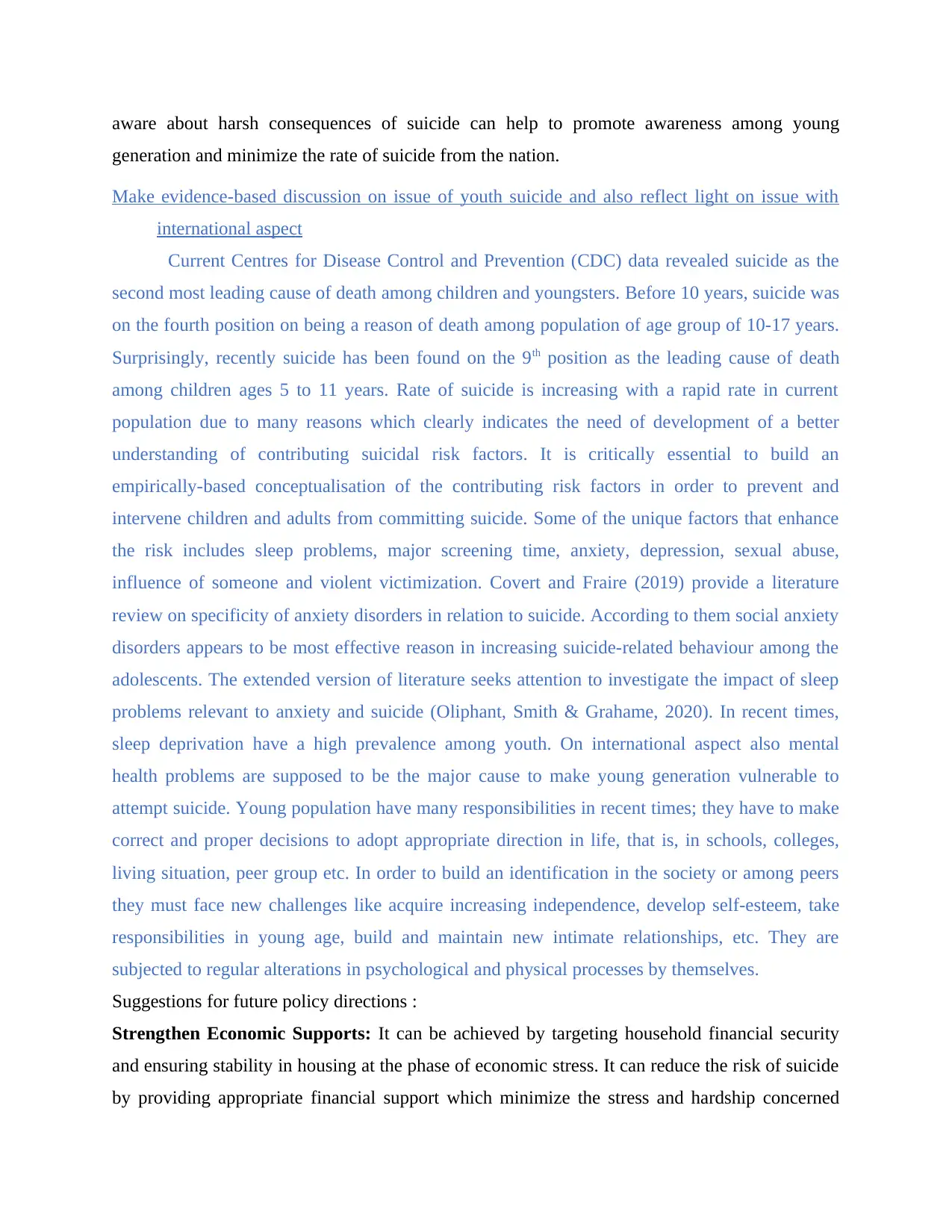
aware about harsh consequences of suicide can help to promote awareness among young
generation and minimize the rate of suicide from the nation.
Make evidence-based discussion on issue of youth suicide and also reflect light on issue with
international aspect
Current Centres for Disease Control and Prevention (CDC) data revealed suicide as the
second most leading cause of death among children and youngsters. Before 10 years, suicide was
on the fourth position on being a reason of death among population of age group of 10-17 years.
Surprisingly, recently suicide has been found on the 9th position as the leading cause of death
among children ages 5 to 11 years. Rate of suicide is increasing with a rapid rate in current
population due to many reasons which clearly indicates the need of development of a better
understanding of contributing suicidal risk factors. It is critically essential to build an
empirically-based conceptualisation of the contributing risk factors in order to prevent and
intervene children and adults from committing suicide. Some of the unique factors that enhance
the risk includes sleep problems, major screening time, anxiety, depression, sexual abuse,
influence of someone and violent victimization. Covert and Fraire (2019) provide a literature
review on specificity of anxiety disorders in relation to suicide. According to them social anxiety
disorders appears to be most effective reason in increasing suicide-related behaviour among the
adolescents. The extended version of literature seeks attention to investigate the impact of sleep
problems relevant to anxiety and suicide (Oliphant, Smith & Grahame, 2020). In recent times,
sleep deprivation have a high prevalence among youth. On international aspect also mental
health problems are supposed to be the major cause to make young generation vulnerable to
attempt suicide. Young population have many responsibilities in recent times; they have to make
correct and proper decisions to adopt appropriate direction in life, that is, in schools, colleges,
living situation, peer group etc. In order to build an identification in the society or among peers
they must face new challenges like acquire increasing independence, develop self-esteem, take
responsibilities in young age, build and maintain new intimate relationships, etc. They are
subjected to regular alterations in psychological and physical processes by themselves.
Suggestions for future policy directions :
Strengthen Economic Supports: It can be achieved by targeting household financial security
and ensuring stability in housing at the phase of economic stress. It can reduce the risk of suicide
by providing appropriate financial support which minimize the stress and hardship concerned
generation and minimize the rate of suicide from the nation.
Make evidence-based discussion on issue of youth suicide and also reflect light on issue with
international aspect
Current Centres for Disease Control and Prevention (CDC) data revealed suicide as the
second most leading cause of death among children and youngsters. Before 10 years, suicide was
on the fourth position on being a reason of death among population of age group of 10-17 years.
Surprisingly, recently suicide has been found on the 9th position as the leading cause of death
among children ages 5 to 11 years. Rate of suicide is increasing with a rapid rate in current
population due to many reasons which clearly indicates the need of development of a better
understanding of contributing suicidal risk factors. It is critically essential to build an
empirically-based conceptualisation of the contributing risk factors in order to prevent and
intervene children and adults from committing suicide. Some of the unique factors that enhance
the risk includes sleep problems, major screening time, anxiety, depression, sexual abuse,
influence of someone and violent victimization. Covert and Fraire (2019) provide a literature
review on specificity of anxiety disorders in relation to suicide. According to them social anxiety
disorders appears to be most effective reason in increasing suicide-related behaviour among the
adolescents. The extended version of literature seeks attention to investigate the impact of sleep
problems relevant to anxiety and suicide (Oliphant, Smith & Grahame, 2020). In recent times,
sleep deprivation have a high prevalence among youth. On international aspect also mental
health problems are supposed to be the major cause to make young generation vulnerable to
attempt suicide. Young population have many responsibilities in recent times; they have to make
correct and proper decisions to adopt appropriate direction in life, that is, in schools, colleges,
living situation, peer group etc. In order to build an identification in the society or among peers
they must face new challenges like acquire increasing independence, develop self-esteem, take
responsibilities in young age, build and maintain new intimate relationships, etc. They are
subjected to regular alterations in psychological and physical processes by themselves.
Suggestions for future policy directions :
Strengthen Economic Supports: It can be achieved by targeting household financial security
and ensuring stability in housing at the phase of economic stress. It can reduce the risk of suicide
by providing appropriate financial support which minimize the stress and hardship concerned
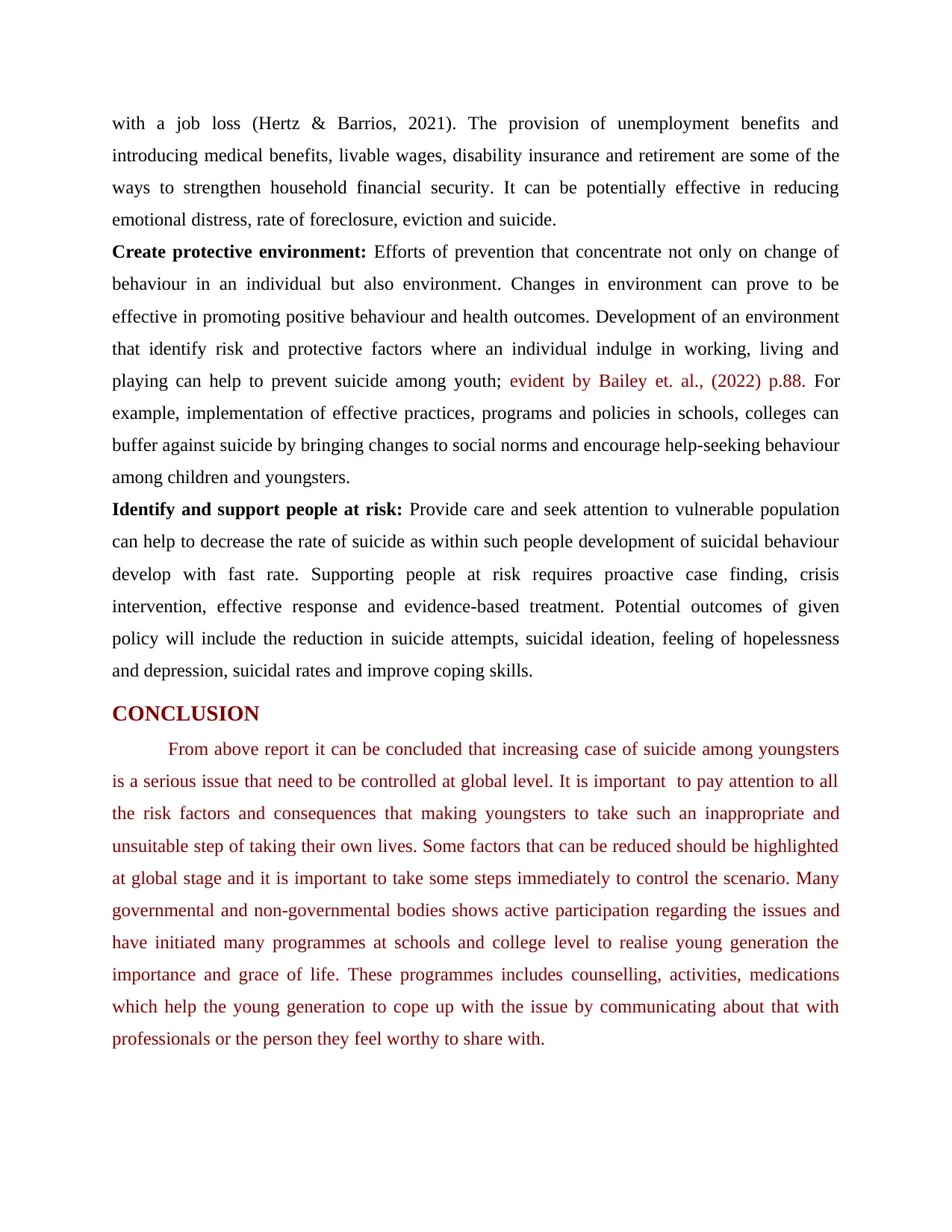
with a job loss (Hertz & Barrios, 2021). The provision of unemployment benefits and
introducing medical benefits, livable wages, disability insurance and retirement are some of the
ways to strengthen household financial security. It can be potentially effective in reducing
emotional distress, rate of foreclosure, eviction and suicide.
Create protective environment: Efforts of prevention that concentrate not only on change of
behaviour in an individual but also environment. Changes in environment can prove to be
effective in promoting positive behaviour and health outcomes. Development of an environment
that identify risk and protective factors where an individual indulge in working, living and
playing can help to prevent suicide among youth; evident by Bailey et. al., (2022) p.88. For
example, implementation of effective practices, programs and policies in schools, colleges can
buffer against suicide by bringing changes to social norms and encourage help-seeking behaviour
among children and youngsters.
Identify and support people at risk: Provide care and seek attention to vulnerable population
can help to decrease the rate of suicide as within such people development of suicidal behaviour
develop with fast rate. Supporting people at risk requires proactive case finding, crisis
intervention, effective response and evidence-based treatment. Potential outcomes of given
policy will include the reduction in suicide attempts, suicidal ideation, feeling of hopelessness
and depression, suicidal rates and improve coping skills.
CONCLUSION
From above report it can be concluded that increasing case of suicide among youngsters
is a serious issue that need to be controlled at global level. It is important to pay attention to all
the risk factors and consequences that making youngsters to take such an inappropriate and
unsuitable step of taking their own lives. Some factors that can be reduced should be highlighted
at global stage and it is important to take some steps immediately to control the scenario. Many
governmental and non-governmental bodies shows active participation regarding the issues and
have initiated many programmes at schools and college level to realise young generation the
importance and grace of life. These programmes includes counselling, activities, medications
which help the young generation to cope up with the issue by communicating about that with
professionals or the person they feel worthy to share with.
introducing medical benefits, livable wages, disability insurance and retirement are some of the
ways to strengthen household financial security. It can be potentially effective in reducing
emotional distress, rate of foreclosure, eviction and suicide.
Create protective environment: Efforts of prevention that concentrate not only on change of
behaviour in an individual but also environment. Changes in environment can prove to be
effective in promoting positive behaviour and health outcomes. Development of an environment
that identify risk and protective factors where an individual indulge in working, living and
playing can help to prevent suicide among youth; evident by Bailey et. al., (2022) p.88. For
example, implementation of effective practices, programs and policies in schools, colleges can
buffer against suicide by bringing changes to social norms and encourage help-seeking behaviour
among children and youngsters.
Identify and support people at risk: Provide care and seek attention to vulnerable population
can help to decrease the rate of suicide as within such people development of suicidal behaviour
develop with fast rate. Supporting people at risk requires proactive case finding, crisis
intervention, effective response and evidence-based treatment. Potential outcomes of given
policy will include the reduction in suicide attempts, suicidal ideation, feeling of hopelessness
and depression, suicidal rates and improve coping skills.
CONCLUSION
From above report it can be concluded that increasing case of suicide among youngsters
is a serious issue that need to be controlled at global level. It is important to pay attention to all
the risk factors and consequences that making youngsters to take such an inappropriate and
unsuitable step of taking their own lives. Some factors that can be reduced should be highlighted
at global stage and it is important to take some steps immediately to control the scenario. Many
governmental and non-governmental bodies shows active participation regarding the issues and
have initiated many programmes at schools and college level to realise young generation the
importance and grace of life. These programmes includes counselling, activities, medications
which help the young generation to cope up with the issue by communicating about that with
professionals or the person they feel worthy to share with.
⊘ This is a preview!⊘
Do you want full access?
Subscribe today to unlock all pages.

Trusted by 1+ million students worldwide
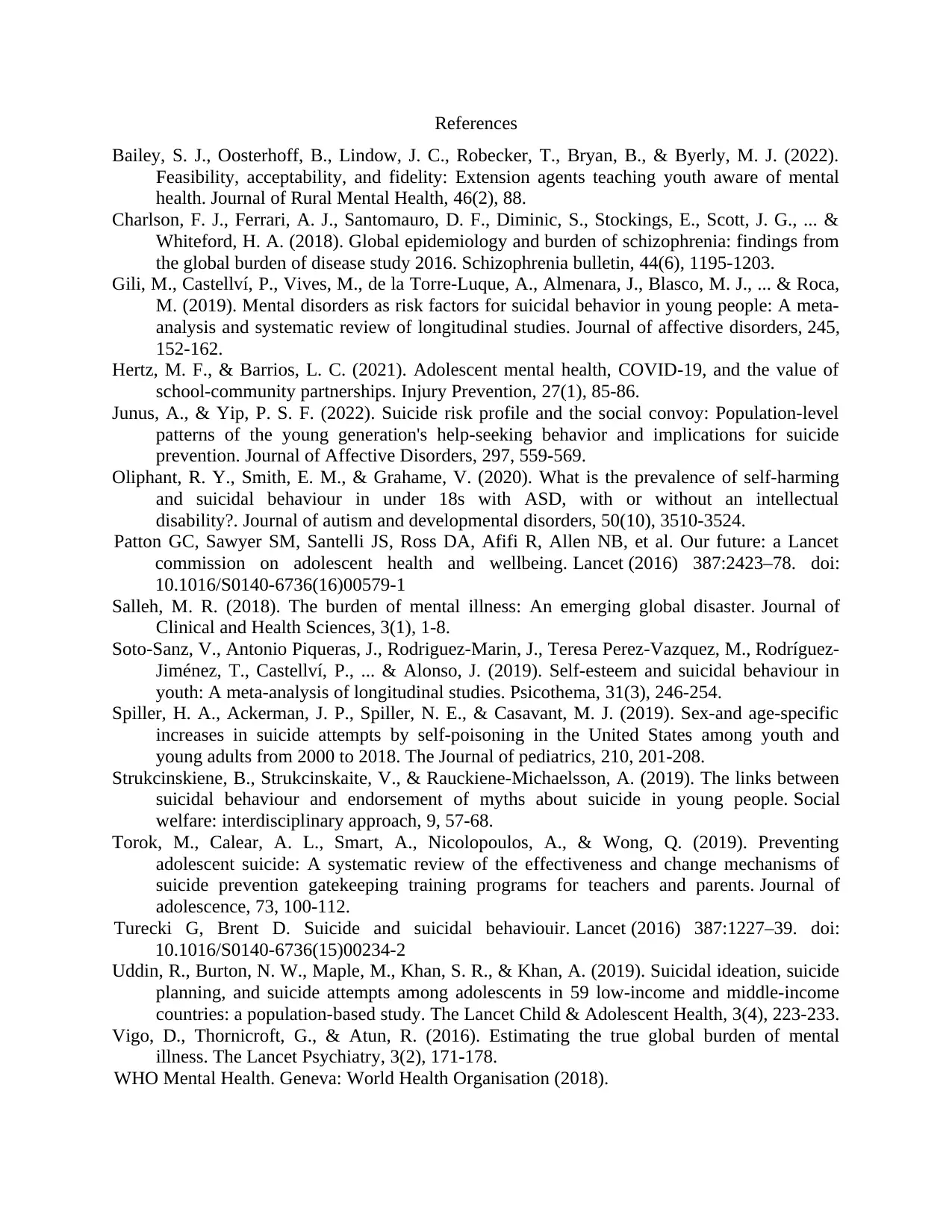
References
Bailey, S. J., Oosterhoff, B., Lindow, J. C., Robecker, T., Bryan, B., & Byerly, M. J. (2022).
Feasibility, acceptability, and fidelity: Extension agents teaching youth aware of mental
health. Journal of Rural Mental Health, 46(2), 88.
Charlson, F. J., Ferrari, A. J., Santomauro, D. F., Diminic, S., Stockings, E., Scott, J. G., ... &
Whiteford, H. A. (2018). Global epidemiology and burden of schizophrenia: findings from
the global burden of disease study 2016. Schizophrenia bulletin, 44(6), 1195-1203.
Gili, M., Castellví, P., Vives, M., de la Torre-Luque, A., Almenara, J., Blasco, M. J., ... & Roca,
M. (2019). Mental disorders as risk factors for suicidal behavior in young people: A meta-
analysis and systematic review of longitudinal studies. Journal of affective disorders, 245,
152-162.
Hertz, M. F., & Barrios, L. C. (2021). Adolescent mental health, COVID-19, and the value of
school-community partnerships. Injury Prevention, 27(1), 85-86.
Junus, A., & Yip, P. S. F. (2022). Suicide risk profile and the social convoy: Population-level
patterns of the young generation's help-seeking behavior and implications for suicide
prevention. Journal of Affective Disorders, 297, 559-569.
Oliphant, R. Y., Smith, E. M., & Grahame, V. (2020). What is the prevalence of self-harming
and suicidal behaviour in under 18s with ASD, with or without an intellectual
disability?. Journal of autism and developmental disorders, 50(10), 3510-3524.
Patton GC, Sawyer SM, Santelli JS, Ross DA, Afifi R, Allen NB, et al. Our future: a Lancet
commission on adolescent health and wellbeing. Lancet (2016) 387:2423–78. doi:
10.1016/S0140-6736(16)00579-1
Salleh, M. R. (2018). The burden of mental illness: An emerging global disaster. Journal of
Clinical and Health Sciences, 3(1), 1-8.
Soto-Sanz, V., Antonio Piqueras, J., Rodriguez-Marin, J., Teresa Perez-Vazquez, M., Rodríguez-
Jiménez, T., Castellví, P., ... & Alonso, J. (2019). Self-esteem and suicidal behaviour in
youth: A meta-analysis of longitudinal studies. Psicothema, 31(3), 246-254.
Spiller, H. A., Ackerman, J. P., Spiller, N. E., & Casavant, M. J. (2019). Sex-and age-specific
increases in suicide attempts by self-poisoning in the United States among youth and
young adults from 2000 to 2018. The Journal of pediatrics, 210, 201-208.
Strukcinskiene, B., Strukcinskaite, V., & Rauckiene-Michaelsson, A. (2019). The links between
suicidal behaviour and endorsement of myths about suicide in young people. Social
welfare: interdisciplinary approach, 9, 57-68.
Torok, M., Calear, A. L., Smart, A., Nicolopoulos, A., & Wong, Q. (2019). Preventing
adolescent suicide: A systematic review of the effectiveness and change mechanisms of
suicide prevention gatekeeping training programs for teachers and parents. Journal of
adolescence, 73, 100-112.
Turecki G, Brent D. Suicide and suicidal behaviouir. Lancet (2016) 387:1227–39. doi:
10.1016/S0140-6736(15)00234-2
Uddin, R., Burton, N. W., Maple, M., Khan, S. R., & Khan, A. (2019). Suicidal ideation, suicide
planning, and suicide attempts among adolescents in 59 low-income and middle-income
countries: a population-based study. The Lancet Child & Adolescent Health, 3(4), 223-233.
Vigo, D., Thornicroft, G., & Atun, R. (2016). Estimating the true global burden of mental
illness. The Lancet Psychiatry, 3(2), 171-178.
WHO Mental Health. Geneva: World Health Organisation (2018).
Bailey, S. J., Oosterhoff, B., Lindow, J. C., Robecker, T., Bryan, B., & Byerly, M. J. (2022).
Feasibility, acceptability, and fidelity: Extension agents teaching youth aware of mental
health. Journal of Rural Mental Health, 46(2), 88.
Charlson, F. J., Ferrari, A. J., Santomauro, D. F., Diminic, S., Stockings, E., Scott, J. G., ... &
Whiteford, H. A. (2018). Global epidemiology and burden of schizophrenia: findings from
the global burden of disease study 2016. Schizophrenia bulletin, 44(6), 1195-1203.
Gili, M., Castellví, P., Vives, M., de la Torre-Luque, A., Almenara, J., Blasco, M. J., ... & Roca,
M. (2019). Mental disorders as risk factors for suicidal behavior in young people: A meta-
analysis and systematic review of longitudinal studies. Journal of affective disorders, 245,
152-162.
Hertz, M. F., & Barrios, L. C. (2021). Adolescent mental health, COVID-19, and the value of
school-community partnerships. Injury Prevention, 27(1), 85-86.
Junus, A., & Yip, P. S. F. (2022). Suicide risk profile and the social convoy: Population-level
patterns of the young generation's help-seeking behavior and implications for suicide
prevention. Journal of Affective Disorders, 297, 559-569.
Oliphant, R. Y., Smith, E. M., & Grahame, V. (2020). What is the prevalence of self-harming
and suicidal behaviour in under 18s with ASD, with or without an intellectual
disability?. Journal of autism and developmental disorders, 50(10), 3510-3524.
Patton GC, Sawyer SM, Santelli JS, Ross DA, Afifi R, Allen NB, et al. Our future: a Lancet
commission on adolescent health and wellbeing. Lancet (2016) 387:2423–78. doi:
10.1016/S0140-6736(16)00579-1
Salleh, M. R. (2018). The burden of mental illness: An emerging global disaster. Journal of
Clinical and Health Sciences, 3(1), 1-8.
Soto-Sanz, V., Antonio Piqueras, J., Rodriguez-Marin, J., Teresa Perez-Vazquez, M., Rodríguez-
Jiménez, T., Castellví, P., ... & Alonso, J. (2019). Self-esteem and suicidal behaviour in
youth: A meta-analysis of longitudinal studies. Psicothema, 31(3), 246-254.
Spiller, H. A., Ackerman, J. P., Spiller, N. E., & Casavant, M. J. (2019). Sex-and age-specific
increases in suicide attempts by self-poisoning in the United States among youth and
young adults from 2000 to 2018. The Journal of pediatrics, 210, 201-208.
Strukcinskiene, B., Strukcinskaite, V., & Rauckiene-Michaelsson, A. (2019). The links between
suicidal behaviour and endorsement of myths about suicide in young people. Social
welfare: interdisciplinary approach, 9, 57-68.
Torok, M., Calear, A. L., Smart, A., Nicolopoulos, A., & Wong, Q. (2019). Preventing
adolescent suicide: A systematic review of the effectiveness and change mechanisms of
suicide prevention gatekeeping training programs for teachers and parents. Journal of
adolescence, 73, 100-112.
Turecki G, Brent D. Suicide and suicidal behaviouir. Lancet (2016) 387:1227–39. doi:
10.1016/S0140-6736(15)00234-2
Uddin, R., Burton, N. W., Maple, M., Khan, S. R., & Khan, A. (2019). Suicidal ideation, suicide
planning, and suicide attempts among adolescents in 59 low-income and middle-income
countries: a population-based study. The Lancet Child & Adolescent Health, 3(4), 223-233.
Vigo, D., Thornicroft, G., & Atun, R. (2016). Estimating the true global burden of mental
illness. The Lancet Psychiatry, 3(2), 171-178.
WHO Mental Health. Geneva: World Health Organisation (2018).
Paraphrase This Document
Need a fresh take? Get an instant paraphrase of this document with our AI Paraphraser
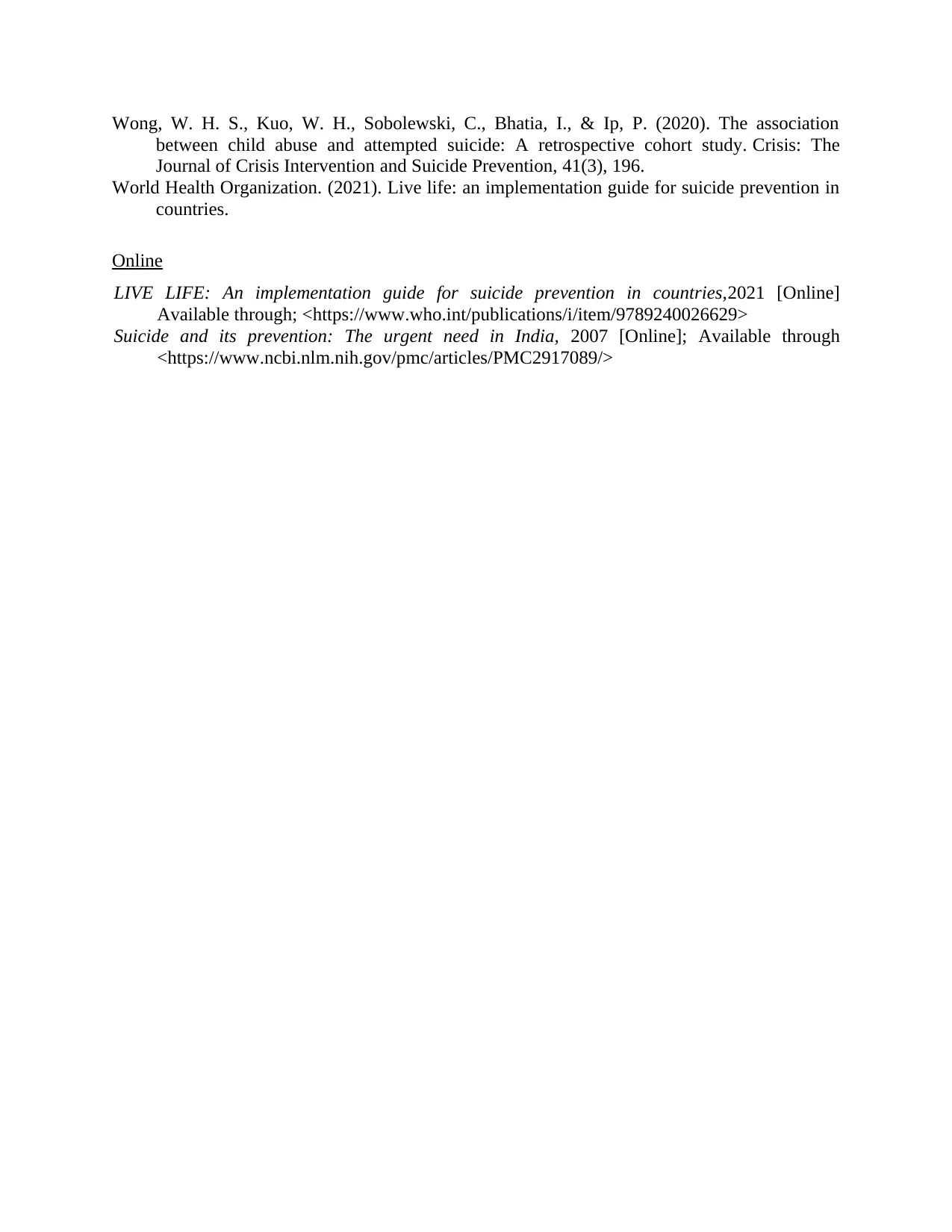
Wong, W. H. S., Kuo, W. H., Sobolewski, C., Bhatia, I., & Ip, P. (2020). The association
between child abuse and attempted suicide: A retrospective cohort study. Crisis: The
Journal of Crisis Intervention and Suicide Prevention, 41(3), 196.
World Health Organization. (2021). Live life: an implementation guide for suicide prevention in
countries.
Online
LIVE LIFE: An implementation guide for suicide prevention in countries,2021 [Online]
Available through; <https://www.who.int/publications/i/item/9789240026629>
Suicide and its prevention: The urgent need in India, 2007 [Online]; Available through
<https://www.ncbi.nlm.nih.gov/pmc/articles/PMC2917089/>
between child abuse and attempted suicide: A retrospective cohort study. Crisis: The
Journal of Crisis Intervention and Suicide Prevention, 41(3), 196.
World Health Organization. (2021). Live life: an implementation guide for suicide prevention in
countries.
Online
LIVE LIFE: An implementation guide for suicide prevention in countries,2021 [Online]
Available through; <https://www.who.int/publications/i/item/9789240026629>
Suicide and its prevention: The urgent need in India, 2007 [Online]; Available through
<https://www.ncbi.nlm.nih.gov/pmc/articles/PMC2917089/>

⊘ This is a preview!⊘
Do you want full access?
Subscribe today to unlock all pages.

Trusted by 1+ million students worldwide
1 out of 12
Related Documents
Your All-in-One AI-Powered Toolkit for Academic Success.
+13062052269
info@desklib.com
Available 24*7 on WhatsApp / Email
![[object Object]](/_next/static/media/star-bottom.7253800d.svg)
Unlock your academic potential
Copyright © 2020–2025 A2Z Services. All Rights Reserved. Developed and managed by ZUCOL.



